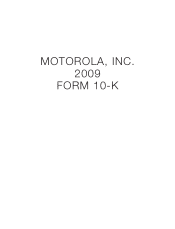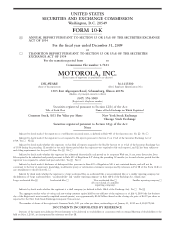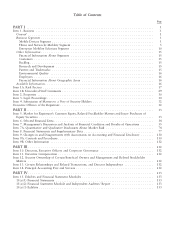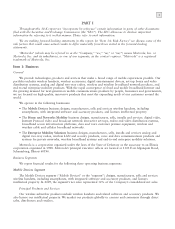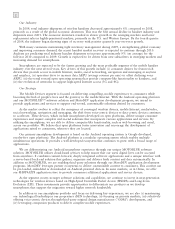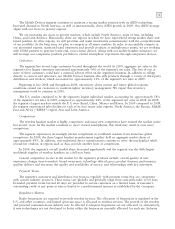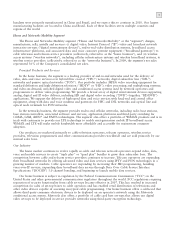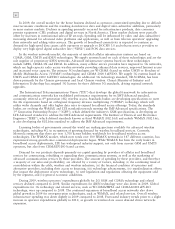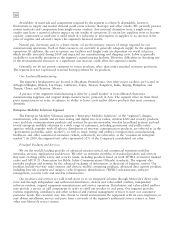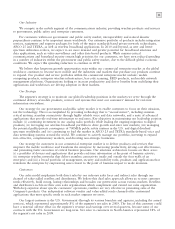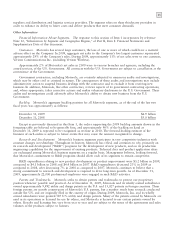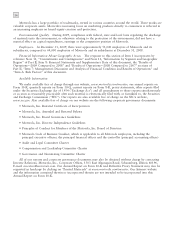Motorola 2009 Annual Report Download - page 15
Download and view the complete annual report
Please find page 15 of the 2009 Motorola annual report below. You can navigate through the pages in the report by either clicking on the pages listed below, or by using the keyword search tool below to find specific information within the annual report.
7
Our Strategy
The Home and Networks Mobility segment is focused on leadership in next-generation broadband solutions
to accelerate the delivery of personal media experiences. Key elements in the segment’s strategy include:
(i) providing for seamless convergence of services and applications across delivery platforms within the home and
across wireline and wireless networks; (ii) innovating and optimizing our end-to-end network portfolio; and
(iii) developing new services that leverage our platforms to provide revenue generating applications and services to
our operator customers while enabling consumers to experience media mobility. As part of our strategy, we have
made and will continue to make strategic acquisitions.
In the home business, we are focused on accelerating the rate of digital penetration by broadband operators
in North America through an enhanced suite of digital entertainment devices. These products include basic
models supporting the industry movement to all-digital delivery and advanced units supporting HD/DVR
functions, as well as convergence of IP Media content in the home. We continue to invest to differentiate our
products and services in areas of software and applications, content on-demand and targeted advertising.
We are capitalizing on telecom operators’ decisions to offer IPTV to their subscribers globally, with products
that support delivery of video content using both copper-outside-plant and fiber-to-the-premises (‘‘FTTP’’)
networks. The segment continues to provide video infrastructure, FTTP access network equipment, advanced
digital entertainment devices and IP interactive set-tops to leading telecommunication companies around the
world. During 2009, we signed a definitive agreement to acquire BitBand, a leading provider of content
management and delivery systems specializing in video-on-demand for IPTV. We are also an industry leader in
broadband data and voice products. We are delivering DOCSIS 3.0 channel bonding on our cable modem
termination systems (‘‘CMTS’’) and cable modems, and deploying our Gigabit PON platform and Very High
Speed Digital Subscriber Line (‘‘VDSL’’) gateways.
In the networks business, the segment provides equipment and services to over 135 GSM, CDMA and iDEN
networks globally. The segment is investing to be a leader in next-generation wireless broadband technologies
with its WiMAX and LTE systems. WiMAX and LTE are evolved wireless broadband technologies that enable
operators to provide improved data performance at lower operating cost. These technologies offer similar
advantages for existing operators and emerging broadband service providers and vary in selection depending on
the desired application and available spectrum. In 2009, the segment delivered WiMAX network equipment to 39
WiMAX networks throughout the world. In addition, at the end of 2009, the segment was participating in 12
WiMAX trials globally, representing new business opportunities in 2010. As a leader in the baseline OFDM
technology used for WiMAX, the segment is leveraging this expertise to accelerate our LTE product offering,
which will support both frequency division duplex (‘‘FDD’’) and time division duplex (‘‘TDD’’) modes. The LTE
standard was ratified in December 2008, enabling operators and vendors to accelerate testing and deployment.
The segment is participating in the LTE system architecture evolution trial initiative.
Customers
In 2009, aggregate net sales to the segment’s five largest customers, primarily large cable operators and
telecommunication companies located throughout the world, represented approximately 45% of the segment’s net
sales. The loss of any of the segment’s large customers could have a material adverse effect on the segment’s
business. Further, because many of the segment’s contracts are long-term, the loss of a major customer could
impact revenue and earnings over several quarters. The segment’s proportion of sales outside of North America
was 51% in 2009, compared to 50% in 2008.
Competition
The businesses in which the segment operates are highly competitive. The rapid technological changes
occurring in each of the markets in which the segment competes are expected to lead to the entry of many new
competitors. Competitive factors in the market for the segment’s products and systems include: technology
offered; product and system performance; price; product features; quality; delivery and availability. We believe
that we are competitively positioned because of our solid relationships with major communication system
operators worldwide, our technology leadership and our new product development capabilities. Price is a major
area of competition and often impacts margins for initial system bids, particularly in emerging markets.
Time-to-market has also been an important competitive factor, especially for new systems and technologies.


